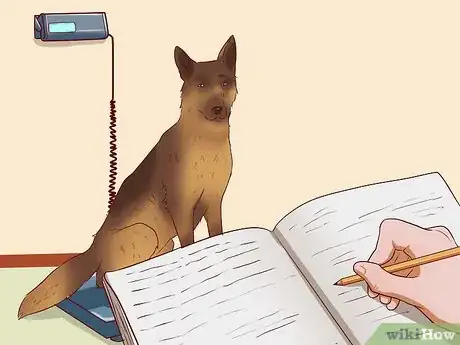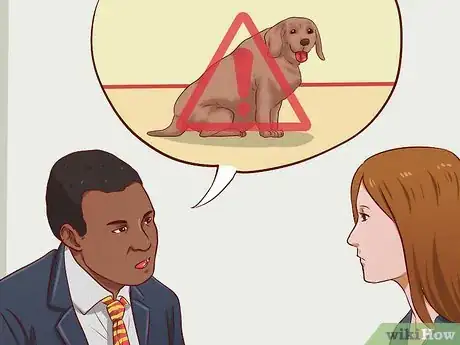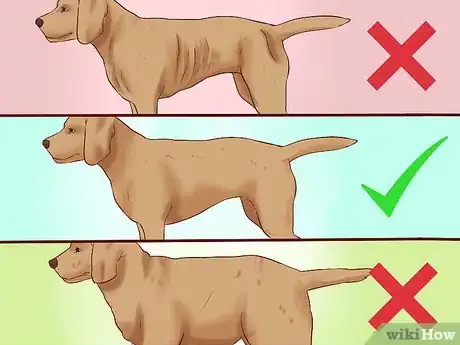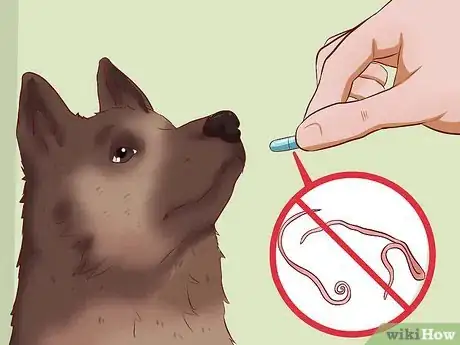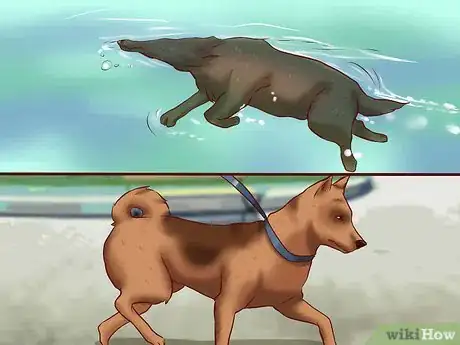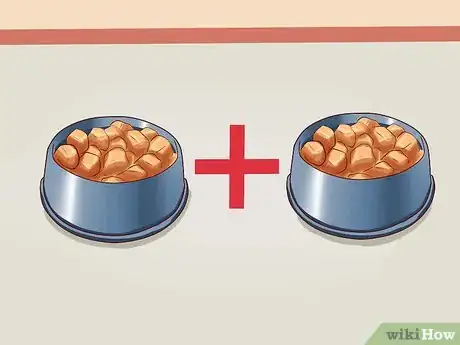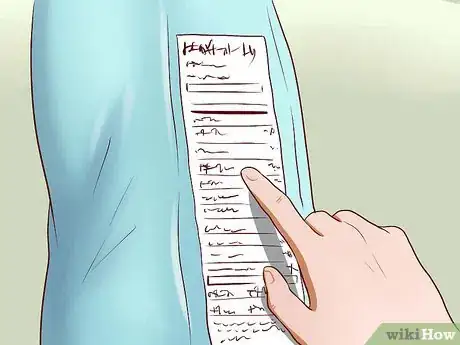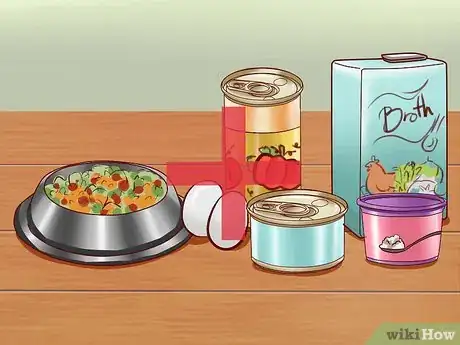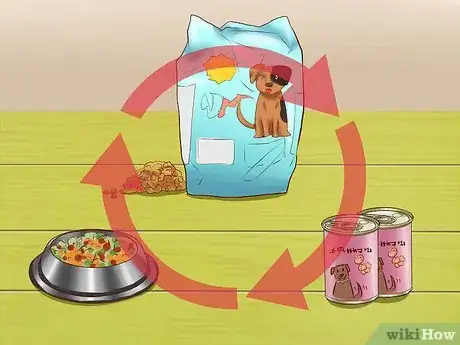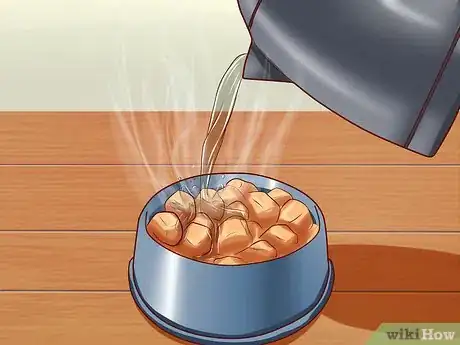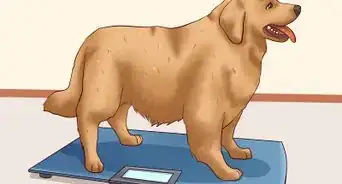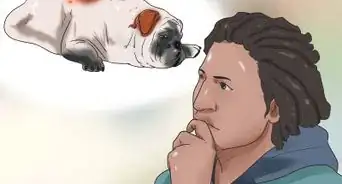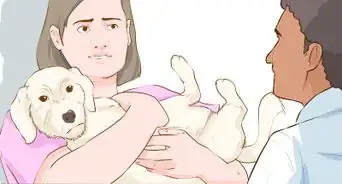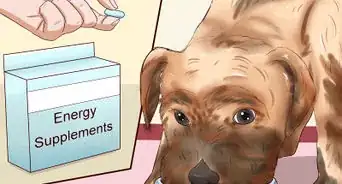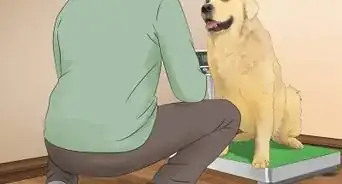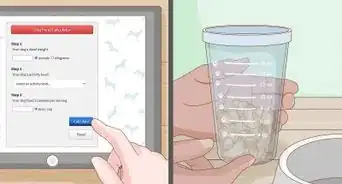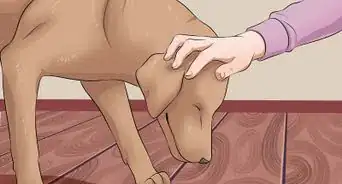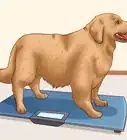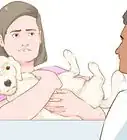This article was co-authored by Beatrice Tavakoli. Beatrice Tavakoli is a Professional Dog Trainer and the Founder/Owner of TAKA Dog Walk in New Jersey. A lifetime dog lover and enthusiast, Beatrice is committed to providing animals with hands-on service dedicated to daily love, adventure, and socialization. As insured and bonded dog walkers, Beatrice, and her staff provide a multitude of services including doggie social hour, day hikes, training, puppy care, canine special events, in-home pet care, boarding, cat care, and customized dog walks.
There are 7 references cited in this article, which can be found at the bottom of the page.
wikiHow marks an article as reader-approved once it receives enough positive feedback. This article received 15 testimonials and 100% of readers who voted found it helpful, earning it our reader-approved status.
This article has been viewed 816,046 times.
Helping your dog maintain a healthy weight is an important part of being a pet owner. Even healthy dogs can be underweight or overweight, but you may be particularly concerned if your dog has lost weight due to an illness or injury. After a trip to the vet to rule out underlying problems, many underweight dogs can gain weight by altering diet and lifestyle.
Steps
Diagnosing Low Weight
-
1Record your dog’s weight. If you believe that your dog is underweight, you need to begin keeping track of the dog’s weight so that you can track the dog’s weight loss, and then his weight gain as you implement weight-gaining strategies. Be sure to share this information with your vet.
-
2Consult a veterinarian. You need to be sure that there is nothing causing your dog’s weight loss that needs medical attention. Your dog may have an illness or parasite that isn’t immediately obvious to you that your vet will be able to determine.
- Illnesses such as diabetes, cancer, hepatitis and inflammatory bowel disease may manifest as weight lost,[1] but require additional treatments and medications. Therefore, a pet with an undiagnosed condition will not improve with food alone. In fact, they will get much worse without proper treatment.
Advertisement -
3Determine your dog’s ideal weight. Talk to your vet about using body conditioning scoring (BCS) to help objectively assess whether your pet is too thin, too heavy or just right. A sample chart can be seen here. If your dog seems underweight based on the BCS, you should talk to your vet about an approach to help your dog gain weight.
- In general, your dog is at a healthy weight if you can see their waist, you can feel their ribs when petting their sides without actually seeing the outline of the ribs and their belly curves upward to meet their hips.[2]
- If you can easily see most or all of the ribs, the backbone or hip bones, your dog is likely too thin.
- Some breeds, like Greyhounds, and some hunting and herding dogs (Border Collies, Pointers) tend to be leaner than other breeds like Mastiffs and Labrador Retrievers.
-
4Deworm your pet. It is best to have your vet do a fecal test for intestinal parasites, but if you are unable to do that, you can diagnose and treat your dog for worms from home.
- A dog that has an intestinal parasite infection may be underweight because the parasite is sapping the nutrition out of the dog’s food before the dog is able to process it.
-
5Ensure that your dog is getting appropriate exercise. A dog’s weight is related to his overall health, and part of your dog’s health is getting adequate gentle exercise.[3]
- Make sure to consult your vet before embarking on a rigorous exercise plan. Some dogs suffer from arthritis, neurological difficulties or metabolic diseases that lead to muscle wasting which would require special treatment under the guidance of your veterinarian to improve your dog’s health without additional injury.
- Gradually increasing controlled walks on leash is usually safe for most dogs and less likely to cause injury. Swimming is a great no impact exercise for dogs who don’t mind getting wet. Make sure the entry and exit from the water are set up to prevent injury getting in and out of the pool, lake, or river.
Adding Calories to Your Dog’s Diet
-
1Add an extra meal into your dog's daily diet. If you feed your dog once a day, add a second meal. If your dog is already fed morning and evening, add a meal during the middle of the day. Do not necessarily change the diet you are already feeding, simply add one more meal to the day to add calories. [4]
- Keep in mind that by increasing your dog’s diet by a whole meal, you are also changing the bathroom habits of your dog, which may require altering your dog walking schedule.
-
2Assess the quality of your dog food. Dog food comes in a wide variety of quality. You should be sure that the food you are feeding your dog is providing an adequate number of calories and an appropriate balance of nutrition.
- Checking the protein and fat content of the food you currently feed is easily done by checking the information provided on the side of the bag.
- The calories per cup will not always be found on the package, so you may have to go to the manufacturer’s website or call the manufacturer to get that information.
- You will also find an ingredient list on the side of the bag. Look for foods that begin the ingredient list with a protein, such as “beef” or “chicken” or “lamb” instead of a carbohydrate like corn or wheat.
- You can check the quality of ingredients of your current dog food http://www.dogfoodadvisor.com/ here.
- Talk to your veterinarian regarding your pet’s nutritional needs including the recommended caloric intake per day for your dog. Additional information can be found at: http://vet.osu.edu/vmc/basic-calorie-calculator.
-
3Supplement the dog’s food with appropriate human food.[5] Adding some yummy, safe “human” food to your dog’s diet can help increase a dog’s enthusiasm for eating. Non-fat, no salt chicken broth, beef broth or vegetable broth is very tasty, especially if you warm it up before placing on top of the dog’s food. You can find non-fat no salt broths in the grocery store pretty inexpensively. A few tablespoons will add nice flavor to your dog’s food.
- A few tablespoons of roasted chicken without the skin, boiled egg or plain sardines (or mackerel) will often help awaken the appetite of most dogs and are healthy sources of protein and calories.
- Dogs can get sick if fed too much fat, so stick to protein and carbohydrates to add healthy calories to the diet.
- Other foods to try are the water from canned tuna, non-fat cottage cheese, non-fat plain yogurt, or plain canned pumpkin.
- Sweet potatoes and salmon oil are other fantastic options.[6]
- Avoid human foods that can be dangerous to dogs’ health, such as chocolate, raisins, grapes, onions, garlic, and anything with mold on it.[7] [8]
-
4Try a different kind of food. If your dog is not responding well to the food he is eating, try giving him a different (high quality) dry food, a high-quality canned (wet) food, or follow a respected homemade dog food diet. High quality pet foods generally list the first ingredient in their formulations as a protein, such as “beef” or “chicken.”
- If you are home cooking the whole diet for a dog over a long period of time, it is extremely important that the diet is complete and balanced nutritionally. Using a reputable source from your veterinarian for your dog food recipes is recommended, and make sure that you don’t leave out any ingredients when you cook.
- No one diet is “perfect” for every dog, so be sure to do some research with the help of your veterinarian before changing to a home-cooked only diet for your pet.[9] A few resources to consider when starting your research are The Whole Pet Diet by Andi Brown [10] and the Dr. Becker's Real Food for Healthy Dogs and Cats by Beth Taylor.
-
5Add water to your dog’s dry food. If your dog is not enthusiastic about eating his dry food, try adding hot water to the dried food then letting it cool so that it's mushy. This often makes the food more appealing to dogs.
Expert Q&A
Did you know you can get expert answers for this article?
Unlock expert answers by supporting wikiHow
-
QuestionHow long should you leave your dog's food out?
 Beatrice TavakoliBeatrice Tavakoli is a Professional Dog Trainer and the Founder/Owner of TAKA Dog Walk in New Jersey. A lifetime dog lover and enthusiast, Beatrice is committed to providing animals with hands-on service dedicated to daily love, adventure, and socialization. As insured and bonded dog walkers, Beatrice, and her staff provide a multitude of services including doggie social hour, day hikes, training, puppy care, canine special events, in-home pet care, boarding, cat care, and customized dog walks.
Beatrice TavakoliBeatrice Tavakoli is a Professional Dog Trainer and the Founder/Owner of TAKA Dog Walk in New Jersey. A lifetime dog lover and enthusiast, Beatrice is committed to providing animals with hands-on service dedicated to daily love, adventure, and socialization. As insured and bonded dog walkers, Beatrice, and her staff provide a multitude of services including doggie social hour, day hikes, training, puppy care, canine special events, in-home pet care, boarding, cat care, and customized dog walks.
Professional Dog Trainer
-
QuestionWhy is free-feeding is bad for dogs?
 Beatrice TavakoliBeatrice Tavakoli is a Professional Dog Trainer and the Founder/Owner of TAKA Dog Walk in New Jersey. A lifetime dog lover and enthusiast, Beatrice is committed to providing animals with hands-on service dedicated to daily love, adventure, and socialization. As insured and bonded dog walkers, Beatrice, and her staff provide a multitude of services including doggie social hour, day hikes, training, puppy care, canine special events, in-home pet care, boarding, cat care, and customized dog walks.
Beatrice TavakoliBeatrice Tavakoli is a Professional Dog Trainer and the Founder/Owner of TAKA Dog Walk in New Jersey. A lifetime dog lover and enthusiast, Beatrice is committed to providing animals with hands-on service dedicated to daily love, adventure, and socialization. As insured and bonded dog walkers, Beatrice, and her staff provide a multitude of services including doggie social hour, day hikes, training, puppy care, canine special events, in-home pet care, boarding, cat care, and customized dog walks.
Professional Dog Trainer
-
QuestionMy 2-month old Lab puppy is underweight. How can I encourage him to gain weight?
 Pippa Elliott, MRCVSDr. Elliott, BVMS, MRCVS is a veterinarian with over 30 years of experience in veterinary surgery and companion animal practice. She graduated from the University of Glasgow in 1987 with a degree in veterinary medicine and surgery. She has worked at the same animal clinic in her hometown for over 20 years.
Pippa Elliott, MRCVSDr. Elliott, BVMS, MRCVS is a veterinarian with over 30 years of experience in veterinary surgery and companion animal practice. She graduated from the University of Glasgow in 1987 with a degree in veterinary medicine and surgery. She has worked at the same animal clinic in her hometown for over 20 years.
Veterinarian Firstly, make sure he is adequately wormed and not suffering from any bowel problems. If his poop is soft or liquid, have the vet send a fecal sample away for analysis to identify any infections that are interfering with his digestion. If the tests come back negative, feed a puppy food designed for large breed dogs and offer small meals 4 - 6 times a day. Estimate his ideal weight and using the feeding guide on the pack, offer the amount for his ideal weight plus 10%. Weigh him weekly and look for slow steady weight gain.
Firstly, make sure he is adequately wormed and not suffering from any bowel problems. If his poop is soft or liquid, have the vet send a fecal sample away for analysis to identify any infections that are interfering with his digestion. If the tests come back negative, feed a puppy food designed for large breed dogs and offer small meals 4 - 6 times a day. Estimate his ideal weight and using the feeding guide on the pack, offer the amount for his ideal weight plus 10%. Weigh him weekly and look for slow steady weight gain.
Warnings
- Be aware that a drastic change to a dog’s diet can cause an upset stomach. Talk to your vet about safely transitioning to a new type of food.⧼thumbs_response⧽
- If you are adding human food, such as pumpkin, to your dog’s diet and your dog has soft stools, you may need to decrease the amount of human food you’re adding to his diet.⧼thumbs_response⧽
- Do not embark on a big exercise routine with your dog if they are not used to it. Just like us they need to gently start then introduce more.⧼thumbs_response⧽
- Don't force your dog to eat, you can only tempt them.⧼thumbs_response⧽
References
- ↑ http://www.petmd.com/dog/conditions/digestive/c_multi_Weight_Loss_and_Cachexia
- ↑ http://www.dogfoodadvisor.com/dog-feeding-tips/dog-ideal-weight/
- ↑ Beatrice Tavakoli. Professional Dog Trainer. Expert Interview. 26 February 2021.
- ↑ http://www.vetinfo.com/whats-the-best-food-for-dog-weight-gain.html#b
- ↑ https://www.cesarsway.com/dog-approved-people-food/
- ↑ Beatrice Tavakoli. Professional Dog Trainer. Expert Interview. 26 February 2021.
- ↑ https://www.aspca.org/pet-care/virtual-pet-behaviorist/dog-behavior/foods-are-hazardous-dogs
- ↑ Beatrice Tavakoli. Professional Dog Trainer. Expert Interview. 26 February 2021.
- ↑ Beatrice Tavakoli. Professional Dog Trainer. Expert Interview. 26 February 2021.
About This Article
To get dogs to gain a healthy amount of weight, visit your veterinarian to ensure there are not any underlying health concerns that need addressed. Sometimes, intestinal worms or illness are the cause of weight loss in dogs. Ask your vet what the ideal weight is for your dog is and what food they suggest. To increase your dog's caloric intake, add another meal to its diet. You can also supplement your dog's regular food with some dog-safe human food, like hard boiled eggs or plain sardines. For more advice on getting your dog to gain weight from our Veterinary reviewer, read on.
